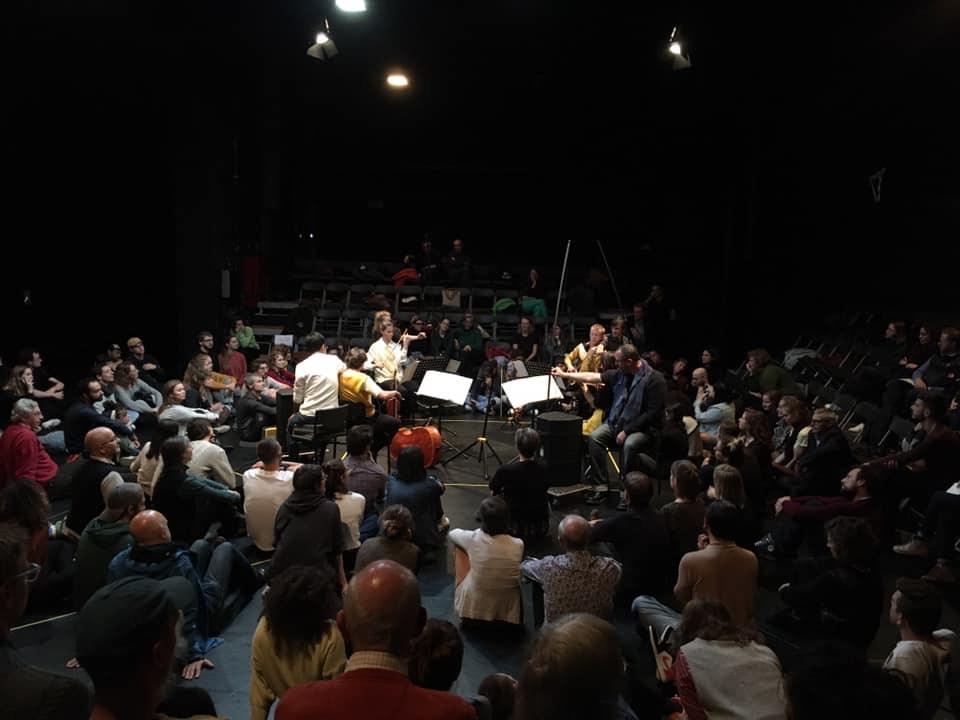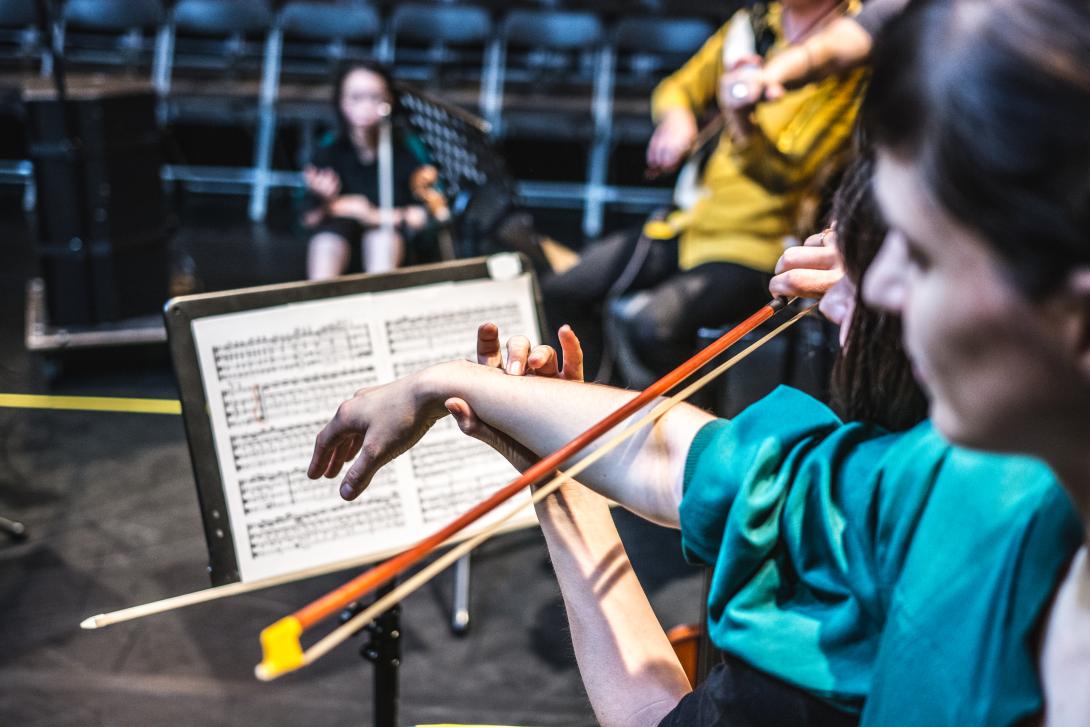Tactile Quartet(s)
Lees het digitaal programmablad van Tactile Quartet(s), met o.a. een tekst van Vera Tussing en JS Rafaeli.
ON TACTILE QUARTET(S)
thoughts by JS Rafaeli and Vera Tussing
How do individuals become groups? What process of authority and submission must be negotiated for a ‘group’ to become something more than the sum of its parts? In what ways is this process coded? In what ways is it embodied? How can it be performed?
The string quartet is one of the most specifically coded constellations in western cultural heritage. Two violins, viola and cello – each element with their prescribed role. Without the monumental grandeur of the orchestra or the absolute intimacy of the solo, the quartet has traditionally meant music for the domestic space – where wider cultural codes are most intimately passed on. The ‘group of four’ also occupies a specifically coded place in dance history as the ‘pas de quatre’ of classical ballet, perhaps most famously exemplified by the Dance of the Cygnets in Lev Ivanow’s choreography of Swan Lake. The ‘pas de quatre’ was generally made up of young women, required to look similar and move in absolute unison. In Tactile Quartet(s) these histories are playfully referenced, interrogated and subverted.
The formation of any ‘group’ carries certain narratives of authority – a process clearly observed in the relationship between musicians and composer. As Georg Friedrich Haas notes, ‘there are very few moments in society when one person can tell another exactly how to move their fingers – and how to breathe’. However, just as musicians receive coded instructions from the composer, in giving their work over to the interpretation of others, the composer in turn places themselves in a position of vulnerability. This is a complex dynamic, an embodied process that plays out in our bodies and on our skin. It resonates in the relationship between choreographer and dancers – and in the wider ‘choreography’ of society at large.
Tactile Quartet(s) is an exploration of how this process of ‘group making’ functions – the processes of authority and consent by which communities are created and engaged in performativity. There are three ‘communities’ in the piece – the quartet of dancers; the musicians of the Quatuor MP4, and the audience. All three of these ‘communities’ carry its own formative and coded rules of conduct. All three come to inhabit the entire theatre space in perhaps surprising ways, and are eventually brought into direct physical contact.
The musicians play excerpts of quartets from canonical works by Franz Schubert and Florence Price, to contemporary pieces by Georg Friedrich Haas, Michael Picknett and Caroline Shaw. The dancers mediate the encounter of musicality and tactility through a choreography that oscillates between the felt, the seen and the heard. Everything arises from touch – a bow on a string, an arm on a shoulder, a sound on your skin. At the point where the orbits of dance and music intersect, the audience is invited to enter into this kaleidoscopic score and asked to lend a hand – or an arm.
For approaching a decade, Vera has been creating what she calls the Tactile Cycle of her work, examining the sense of touch in performance – and how the direct tactile contact between performer and audience can function in the theatrical context. Touching, being in touch, is an intrinsic part of the human experience at large.
Through touch we learn how to situate ourselves in the world. Yet, our culture – particularly our performance culture – privileges (one could say fetishises) the sense of sight. The evolution and ubiquity of smartphones and ‘screen culture’ has in many ways accelerated this process – putting us in communication, but out of touch.
Essential to this ‘cycle’ of work has been the idea of consent – how any touch that occurs must be approached with absolute agency, must be the site of negotiation and agreement, not coercion or exploitation. The recent explosion of consciousness around the #MeToo movement has brought these concerns into particular focus, widening the concerns to broader questions of how groups are made.
Each of Vera’s creation process begins with the acknowledgement of the people she invites into the studio – what does each individual bring to the work, how does that amplify each of the other collaborators?
Tactile Quartet(s) is an attempt to situate these explorations within the formalised coded zones of aesthetic production – and ultimately, gently, on our skin.
THE MUSIC – SHORT NOTES
Quatuor MP4
The MP4 Quartet was created in 2008 by Claire Bourdet, Margaret Hermant, Pierre Heneaux and Merryl Havard, graduates of the Royal Conservatoires of Belgium. Their practice is defined both through performing classical masterpieces, and supporting new work. Working almost continuously for over ten years, MP4 have performed and created work with some of the most celebrated names and institutions across Belgium and internationally.
Georg Friedrich Haas – 2nd String Quartet (1998)
Georg Friedrich Haas is widely considered to be one of the most important living composers. He is a leading proponent of microtonality – roughly put, the exploration of the sounds that sit between the twelve semi-tones of the traditional Western octave.
This quartet explores a different way of thinking about composition – a process driven technique. Underpinning the surface complexity of the piece is one of the simplest things you can do in music, a single sustained note played on the cello. All other sounds we hear are overtones of this pitch. There is a particular interest in the absolute precision of positioning of the musician’s left hand playing a precise pitch that resonates with the cello note – but also in subtle changes of bow pressure, relating to the volume of the notes being played.
Haas has also spoken eloquently about the dynamics of authority and compliance in music creation – particularly related to his own origins as the child of Nazi parents, and his openly BDSM relationship with the American performer and writer, Mollena Williams–Haas.
Florence Price – String Quartet in G Major (1929)
Florence Price was an American composer who lived and worked in the southern states of the US. Her music often reflects the wide landscapes of the south, incorporating elements of southern folk song and church music. After her death, her music was almost forgotten as musical tastes changed. However, in 2009 a large collection of her scores and papers was discovered in an abandoned house which fuelled a resurgence of interest in her music.
The String Quartet in G Major frequently structures its melodic lines on a pentatonic scale – familiar as the underpinning of most western popular music. The pentatonic scale and open harmony contributes to the broad, sweeping, ‘American’ feel of the piece – perhaps reminiscent of early-20th century Hollywood films. For the players, the piece is also characterised by quick changes between pizzicato plucking and bowing techniques – arco in music terminology. We were particularly drawn to the way the melody passes between the players – each voice is part of a whole, but distinctly individual.
Caroline Shaw – Entr’acte (2011)
Born in 1982, Caroline Shaw is the youngest person to win the Pulitzer Prize for Music.
As a violinist by training, she brings a particular awareness and sensitivity towards the potentialities of writing for strings. In an interesting reflection on conceptions of hierarchies and authority in music making, Shaw specifically refers to herself as a ‘musician’ rather than a ‘composer’.
Entr’acte follows a clear structural journey – moving between lyrical simplicity and atonal complexity, and everything in between. There are a multiplicity of techniques at play in this piece – including pizzicato, Bartok pizzicato, natural harmonics, artificial harmonics, ‘fall off gestures’, sul tasto and more.
This leads to complex and diverse tactile engagement between the player and their instrument – fascinating for both a performer and listener. We return to this work frequently throughout Tactile Quartet(s).
Franz Schubert – Death and the Maiden (String Quartet No. 14 in D minor, 1824)
Despite dying at 30, Schubert left behind a stunningly prolific collection of work, that for many has come to symbolise the transition from the classical to the romantic eras of orchestral music.
This is one of the most famous string quartets of all time – the melody may well be familiar. The piece is sublimely ordered, each part fitting together in an elegant clockwork to create a new whole. We were drawn to how it utilises short repeated patterns that sound simple on their own, but achieve a great sophistication when played together – all providing a bed for the beautiful cello melody.
Michael Picknett – Price-Haas Task (2019)
Michael Picknett holds a doctorate in Composition from Guildhall School of Music and Drama, London. His background is in devised composition, working with musicians in subverting many of the traditional hierarchies often involved in ‘group forming’ within musical production, interrogating the potentialities inherent in the relationship between the task giver, and the performer.
In building the musical language of Tactile Quartet(s), Michael created task based scores through which the MP4 Quartet could interact with the other pieces we were working with, and set them in conversation with one another. These tasks were often driven by concepts of following, supporting and leading as compositional techniques. They ask the performers strive for a tactile sensitivity to the music, and the group, drawing awareness to differences between the four musicians and the four composers.

